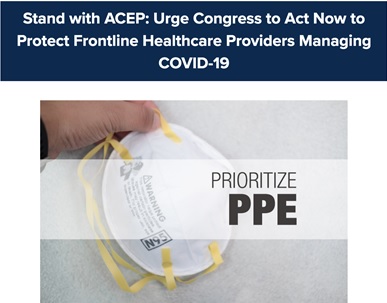Case Study: How ACEP Directed 100,000 Messages to Congress about PPE Shortages
In February 2020, most Americans had never heard the term personal protective equipment, or PPE, as it is known. Yet by the end of March, members of Congress were using the term on cable news. In fact, they had received more than 100,000 emails about the dire shortage of PPE endangering emergency physicians and other healthcare providers on the front lines of COVID-19.
Those emails weren’t random. The American College of Emergency Physicians (ACEP) had run a digital advocacy campaign using technology from Phone2Action. We at ACEP tell this story because we believe it can serve other associations during the pandemic and beyond.
First, we’ll break down the campaign strategy, mechanics and results. Then, we’ll distill the best practices that can elevate your association’s voice on Capitol Hill.
The Catalyst
Emergency physicians began to raise alarms about PPE shortages early in the COVID-19 crisis. They needed PPE to protect themselves, their colleagues and their families. If the virus knocked emergency medical staff out of action, who would take care of patients?
The PPE shortages became so dire that ACEP’s members, numbering more than 38,000, began to obtain N-95 masks from hardware stores and gracious donors. Inexplicably, some hospital administrators prohibited them from using this outside PPE and even threatened to fire those who did.
ACEP members needed Congress and the White House to raise production and distribution of PPE immediately. But with travel and in-person gatherings unsafe, ACEP’s response had to be digital.
The Campaign Mechanics
ACEP worked with Phone2Action developed a campaign titled “Prioritize PPE.” It included a unique landing page, https://p2a.co/kWj7kKr, which enabled advocates to send messages to their Representatives and Senators in one tap.
The landing page included a preloaded message urging the Administration and Congress to “…exhaust every option available to increase PPE production and prioritize distribution to emergency physicians and other frontline providers.”
On Saturday, March 14, ACEP emailed this link to members and posted it on Facebook and Twitter. The post included this graphic:

By the end of Sunday, more than 4,500 people had participated in the campaign, and eventually, the Facebook post would be shared more than 830 times. ACEP members reported that their friends and family wanted to participate, so we created a public version of page as well.
The Results
Between March 15 and March 24, 33,000 people participated in the Prioritize PPE campaign, sending more than 100,000 messages to Congress. Total participation hit nearly 35,000 people, with 70% having never joined an ACEP campaign before. In the three months prior to March 13, 2020, ACEP had acquired 708 new advocates. Between March 13 and May 11, it acquired 40,007, a 5,551% increase.
This collective effort made an impression. Congressional offices acknowledged ACEP’s messages, and soon, members of the media and Congress were advocating for PPE – using that industry term – rather than talking about “masks,” as they had before.
In April, ACEP commissioned a public opinion poll about PPE, which told them 97% of respondents believed that the federal government ought to increase access to PPE for emergency physicians. The advocacy campaign, combined with TV appearances, virtual lawmaker briefings, and social media activity, brought PPE to the forefront of the COVID-19 conversation.
Lessons and Best Practices
The physical danger to ER physicians made this campaign impossible to ignore. That said, a few tactical choices were important to the campaign’s success. We offer these three best practices.
1. Choose an emotive, actionable issue.
PPE was not the only policy priority for ACEP. However, ACEP couldn’t run an advocacy campaign covering all of its priorities; otherwise, the message would be too diffuse to catch the attention of lawmakers.
PPE was by far the best rallying point. It surprised no one that physicians need protection from the virus. But it surprised everyone that there was a nationwide shortage of this life-saving equipment.
This emotive, shareable cause benefited from a nationwide increase in social media activity (likely a side effect of keeping people home). Since March 13, Phone2Action has seen social sharing of advocacy content increase by 411% on Facebook and 150% on Twitter.
2. Elicit personal stories.
ACEP debated whether to make the preloaded message to Congress editable – and ultimately did. Many ACEP members chose to add content, which made these messages more personal and therefore more compelling to lawmakers.
Once reports emerged that some physicians were banned from using donated PPE, ACEP began to collect their stories and shared these with members of Congress. As an example, one physician wrote:
“I was told to remove my own supplied PPE by our security guards because it was frightening our patients. I politely explained my position and that I felt it best to wear. He replied the hospital was told to not allow this.”
Next time, we will ask for these stories earlier and publicize them more widely. They shined a light on an unknown and critical aspect of the PPE crisis.
3. Harness the momentum
ACEP is ready to build on the PPE campaign. For potential members who participated, ACEP offered a free, three-month membership trial. They also matched advocate data to their member database to discern who was active in this PPE effort – useful information for future advocacy initiatives.
The Aftermath
The ACEP campaign raised awareness of PPE and spurred action at the highest levels of government. It also helped ACEP form a broader coalition of partners.
For example, Marriott is now providing free rooms for emergency physicians who need to isolate or decontaminate to protect their families. Elemeno Health and EvidenceCare, both technology providers, are helping ACEP members share and scale the most effective COVID-19 treatments.
The pandemic has splintered Congress’s attention, but organizations that run effective digital advocacy campaigns have a chance to capture it. As a source of credible information, your association can guide our lawmakers to critical issues and, in doing so, shape the outcome of this entire crisis.
Editor’s Note: Naylor is not affiliated with Phone2Action.



